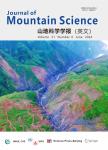Using Path Analysis to Identify the Influence of Climatic Factors on Spring Peak Flow Dominated by Snowmelt in an Alpine Watershed
Using Path Analysis to Identify the Influence of Climatic Factors on Spring Peak Flow Dominated by Snowmelt in an Alpine Watershed作者机构:State Key Laboratory of Desert and Oasis Ecology Xinjiang Institute of Ecology and Geography Chinese Academy of Sciences Graduate School University of Chinese Academy of Sciences Department of Civil and Environmental Engineering University of Nevada Las Vegas NV 89154-4015 USA Faculty of Geomatics Lanzhou Jiaotong University
出 版 物:《Journal of Mountain Science》 (山地科学学报(英文))
年 卷 期:2014年第11卷第4期
页 面:990-1000页
核心收录:
学科分类:07[理学] 070601[理学-气象学] 0706[理学-大气科学]
基 金:financially supported by the Project of State Key Basic R & D Program of China (973 Program, Grant No. 2010CB951002) the key deployment project of Chinese Academy of Sciences (Grant No. KZZD-EW-12-2) Chinese Academy of Sciences Visiting Professorship for Senior International Scientists (Grant No. 2011T2Z40)
主 题:Snowmelt Peak flow Path analysis Alpine watershed
摘 要:Spring snowmelt peak flow (SSPF) can cause serious damage. Precipitation as rainfall directly contributes to the SSPF and influences the characteristics of the SSPF, while temperature indirectly impacts the SSPF by shaping snowmelt rate and determining the soil frozen state which partitions snowmelt water into surface runoff and soil infiltration water in spring. It is necessary to identify the important and significant paths of climatic factors influencing the SSPF and provide estimates of the magnitude and significance of hypothesized causal connections between climatic factors and the SSPF. This study used path analysis with a selection of five factors - the antecedent precipitation index (API), spring precipitation (SP), winter precipitation as snowfall (WS), 〈0℃ temperature accumulation in winter ([ATNI), and average 〉0℃temperature accumulation in spring (AT) - to analyze their influences on the SSPF in the Kaidu River in Xinjiang, China. The results show that {ATN}, AT and WS have a significant correlation with the SSPF, while API and SP do not show a significant correlation. AT and WS directly influence the SSPF, while as the influence of[ATN] on SSPF is indirect through WS and AT. The indirect influence of [ATN[ on SSPF through WS accounts for 69% of the total influence of [ATN] on SSPF. Compared to the multiple linear regression method, path analysis provides additional valuable information, including influencing paths from independent variables to the dependent variable as well as direct and indirect impacts of external variables on the internal variable. This information can help improve the description of snow melt and spring runoff in hydrologic models as well as the planning and management of water resources.



